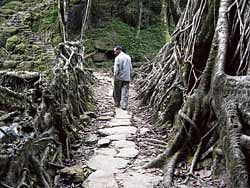A village clean and green

Most of our cities are unlivable - congested and potholed roads, overflowing drains, erratic power and water supply, garbage strewn around so much as to cause accidents like the one recently in Bangalore, when a girl lost her life after her two-wheeler skidded on waste. But here’s a village that looks cleaner than our average city! Welcome to Mawlynnong in Meghalaya.
About 90 km south of Shillong, Meghalaya’s capital, and barely 4 km from Bangladesh border, this village tells us an amazing story of cleanliness, environmental conservation and civic discipline.
Picturesque landscape, well-asphalted roads (you really miss the potholes!) - the village exudes grace and tranquility. There are 87 houses and 485 people. The place is so spic and span that we did not find even a tiny bit of paper or dry leaf anywhere, a miniature version of the much-talked about City-State Singapore. Flowerbeds of all hues dot both sides of the roads.
Shillong is the usual base camp for most tourists. It is some 100 km from Guwahati, the closest big city. Though it has a small airport, Shillong, has no railway station, so most tourists take a transport bus or tourist taxi from Guwahati. From Shillong, the best way to get to Mawlynnong is to hire a tourist taxi, since there are no direct buses. Some hotels arrange transportation; and cab rates vary depending on the
season and the rush and also the state of the road which is sometimes in a bad condition because of landslides.
The village - which is spread around 2 acres - is known as “God’s Own Garden” has, not surprisingly, got the tag of cleanest in Asia from Discovery India magazine in 2003. Lurshai Pyngrope, one of the residents, who described himself as “in charge of the village” and welcomed us and other tourists, says, “Cleanliness and hygiene are a part of our culture.” Justifiably proud of its achievement, the village has rapidly turned into a major tourist destination in the north-east. People keep up the tradition of cleanliness and it is there for all to see. “Children are taught from young age not to litter the place, and to keep the surroundings clean,” he says.
The maintenance of the village is remarkable. The villagers have formed a committee comprising a headman and 10 members to take care of maintenance, drinking water and sanitation. There is a 24-hour water supply sourced from a stream 5 km away through pipes and untouched by humans. “The committee keeps a tab on each and every aspect of village life,” Pyngrope adds. The result of conserving the forest and planting new ones are showing - green is in abundance.
There is a dustbin made of bamboo at every street corner. Two women appointed by the community centre sweep the roads clean. Though there is no ban on plastic, it is discouraged. The entire village is a no-smoking zone. Each house digs up a 20-foot deep pit for dumping garbage and it becomes manure later. Plastic is dumped in a pit outside the village. People found littering are warned twice or thrice and then fined between Rs 50 and Rs 100.

There are seven villages nearby, but they aren’t as clean as this one in Mawlynnong. “We invite committee members from those villages to our village to create awareness about cleanliness, health and hygiene,” says Pyngrope. Money for the upkeep and development of the village comes from a variety of sources: one from tourists by way of donations and the other, more substantial amount, from two government schemes - Integrated Wasteland Development Programme and Swaranjayanti Gram Swarojgar Yojana.
Mawlynnong has a defence committee and a sports club. The defence committee takes up crime-related issues and informs police, if need be. The sports club organises football matches. The villagers are mainly Khasi tribals. Though they cultivate betelnut, and both men and women follow the age-old tradition of chewing it, no one spits or dirties the surroundings.
Another striking feature of the village is that it has a school with classes up to eighth and literacy rate is 100 per cent. Most of them speak English. There are four upper primary and two lower primary and two nursery school teachers, two of whom come from a place some 30 km away from Mawlynnong. They have free accommodation near the school and go home only during the weekends. These teachers have been appointed under the Sarva Shiksha Abhiyaan.
The only drawback is that the nearest primary health centre is around 20 km away. Transportation is mainly by an SUV and two Maruti cars at an
average cost of Re 1 for a km. These vehicles belong to residents of the village, who have rented them out for the benefit of the travelling public.
“The tribals follow matriarchal system where women play a leading role. Most of the shops and eateries are manned by women while men do the
difficult tasks. Since cultivation is the main occupation, men do the task of clearing and making the land ready for the crop while women take care of the sowing. Some villagers entertain the tourists in their homes where they provide tea and snacks,” says a resident of Shillong.
Root bridge
Further inside the village, another attraction is the root bridge, which is nothing but interwoven roots of a tree, over a stream. A boy, collecting Rs 10 as
entrance fee, said the tree was around 150 years old. For the last six years, visitors have been pouring in to see this amazing natural wonder.
Nearby there’s also a huge rock that’s balanced on a much smaller one. There’s no one manning it right now, though it’s been secured with a metal barricade. And this too has become a major tourist attraction.